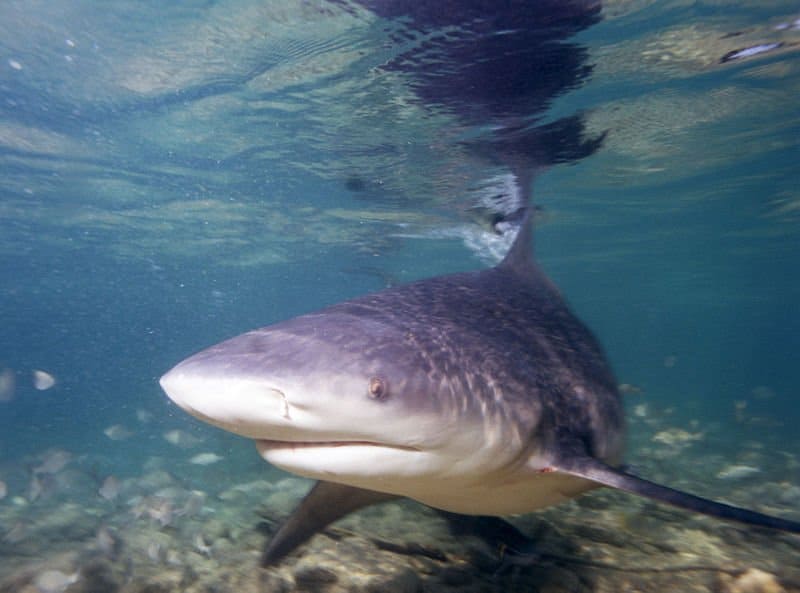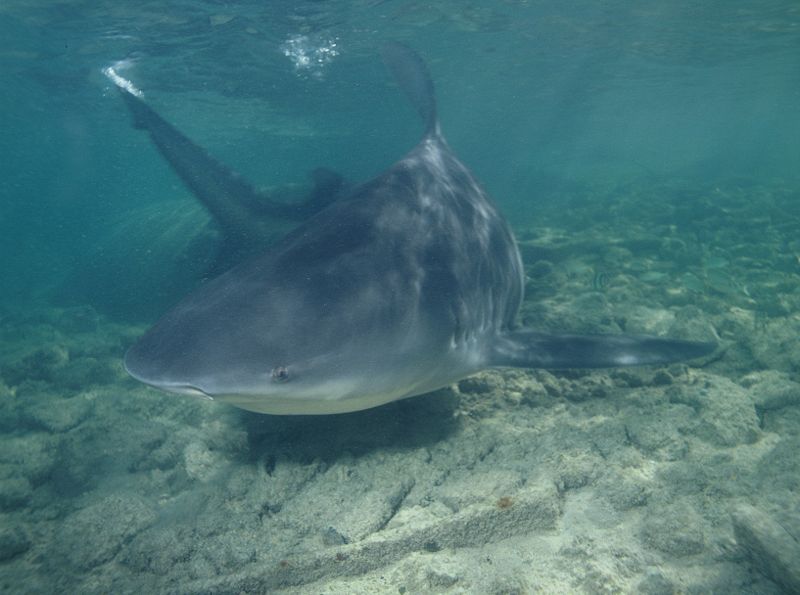If you remember the Jaws theme song and still have nightmares about it, then it may be a good idea to prepare yourself to read this article. This article is about sharks. You may dread Shark Week every year, but sharks aren’t all that dangerous. In fact, sharks don’t usually attack humans and it has only happened several handful of times in the past few decades. Sharks generally eat fish or other small marine creatures. Humans are not part of their diet, don’t worry. Although sharks mainly inhabit saltwater areas like oceans, there have been a few sightings in freshwater. It is safe to say that you can dip your toes in a river or lake without running into a shark. But let’s take a look at the five terrifying times sharks have appeared in American freshwaters.
1937 St. Louis Bull Shark

The average bull shark can weigh from 200 to 500 pounds and grow up to 11 feet long.
©iStock.com/Divepic
It is said that bull sharks, although they are not freshwater sharks, do swim in rivers. They can withstand being in freshwater longer than other sharks. Bull sharks are also considered some of the most dangerous of sharks. On the Mississippi River, the second-longest river in the United States, in the St Louis area, there was a 1937 shark sighting. Two fishermen caught a bull shark weighing 84 pounds on the river. This has become the first reported case of a bull shark sighting in American freshwaters, but it wouldn’t be the last time.
1995 St. Louis Bull Shark

Bull sharks may eat fish, but they can also eat animals as big as sea turtles and dolphins.
©Harry Collins Photography/Shutterstock.com
The wild part is that a fisherman caught another bull shark in 1995 near Rush Island, MO. This happened fifty-eight years after the last bull shark sighting on the Mississippi River near St. Louis. It is said that bull sharks have been swimming in rivers for many many years, but it is becoming more frequent with the world’s climate change. This 1995 bull shark sighting has been verified by researchers, as well as the previous 1937 bull shark sighting.
1955 Lake Michigan Supposed Shark Attack

You can find bull sharks all over the world but inhabit the coastal salt waters more often.
©Willyam Bradberry/Shutterstock.com
There’s a reason why the Lake Michigan shark attack is titled “supposed.” There isn’t really hard evidence to prove that a shark attack actually happened. On January 1, 1955, a boy named George Lawson was swimming in Lake Michigan when he was bitten by a bull shark. There are a number of things wrong with that sentence. Swimming in Lake Michigan in January can be very cold for a human, but it is also cold for a shark. So this shark sighting is unlikely, but one that is a tall tale and this neck of the woods.
Neuse River Sightings

The reason why bull sharks can be found in freshwater is that they can regulate their salt levels.
©Albert Kok, CC BY-SA 3.0, via Wikimedia Commons – License
There have been several sightings in the Neuse River in North Carolina. Bull sharks are the ones that are more likely to swim around the Neuse River. The reason why we know that there have been documented sightings in the Neuse River is that a graduate student from Duke University, Meagan Dunphy-Daly, tagged several bull sharks that she spotted in 2011. Perhaps bull sharks follow prey and that is why they end up in freshwater rivers.
Everglades Sightings

Bull sharks are the species of sharks more responsible for human attacks.
©Albert Kok at Dutch Wikipedia (Original text: albert kok), Public domain, via Wikimedia Commons – License
Lastly, we come to a more common occurrence — bull shark sightings in the Everglades. The Everglades are filled with freshwater and eventually, this freshwater will mix in with the saltwater of the ocean. But bull sharks are known to swim into freshwater, even though you’d think that only crocodiles are the terrifying predators around the Everglades. There are a few species other than bull sharks that are known to adapt to the fresh water. Those are blacktip sharks and lemon sharks. In fact, the rivers that are located in and around the Everglades are prime locations where blacktip sharks and lemon sharks usually roam around.
Conclusion

©Rich Carey/Shutterstock.com
And there you have it, these are the five terrifying times sharks have appeared in American fresh waters. There is one important thing to note. The number is not really exact. There are documented findings of bull sharks in freshwater in the United States. But there have been undocumented sightings as well. There have been numerous sightings of bull sharks in rivers near coasts like in the Everglades or the Neuse River in North Carolina. We may not know the exact number of shark sightings in freshwater in the United States, but we do know that it is becoming much more common due to climate change and the Earth’s waters becoming warmer.
The photo featured at the top of this post is © Fiona Ayerst/Shutterstock.com
Thank you for reading! Have some feedback for us? Contact the AZ Animals editorial team.






